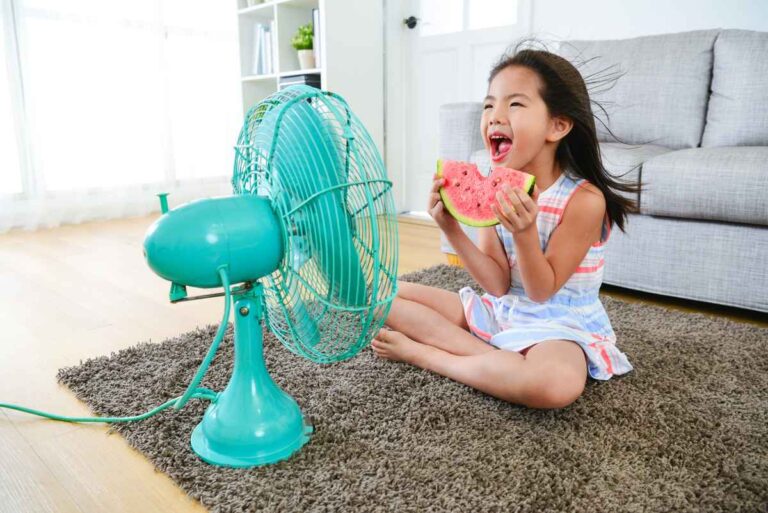Summer heat can turn your cozy home into a sweaty nightmare faster than you can say “popsicle.” Trust me, I’ve been there.
Those sticky nights tossing and turning, the electric bill that makes you gasp, and that moment when you walk inside expecting relief only to find it’s almost as hot indoors as out.
But here’s the good news – you don’t need to suffer through another summer of discomfort.
I’ve spent years testing and tweaking my own home to beat the heat, and I’m going to share everything I’ve learned with you.
10 Ideas To Keep Your Home Cool During Summer
Summer cooling isn’t just about cranking up the AC until your electric meter spins like a ceiling fan. Smart homeowners know that keeping cool is about working with nature, not against it. These ideas will help you stay comfortable without watching your money fly out the window.
Optimize Natural Ventilation
Let’s talk about using what’s free – air movement! The trick is knowing when to open those windows and when to keep them shut.
Open your windows during the cool morning hours and evenings. Create a cross-breeze by opening windows on opposite sides of your house. This pulls cool air through your home naturally.
Close everything up tight (windows, blinds, curtains) during the hottest part of the day, usually 10 AM to 4 PM. You’re essentially sealing in the cool morning air.
Try this neat trick I learned from my grandmother: hang a damp sheet in front of an open window on the breezy side of your house. As air passes through the sheet, it gets cooled by evaporation before entering your home. It’s like a DIY swamp cooler!
A box fan facing outward in an upstairs window can pull hot air out while drawing cooler air in through downstairs windows. Heat rises, so use this to your advantage.
Install or Upgrade Window Coverings
Windows are basically heat magnifiers. According to the Department of Energy, about 76% of sunlight that falls on standard double-pane windows enters your home as heat. Yikes!
Cellular shades (also called honeycomb shades) trap air in their pockets, creating insulation between your window and room. They can reduce heat gain through windows by up to 60%.
Blackout curtains aren’t just for vampires or night shift workers! They block sunlight completely and can reduce heat gain by up to 33%. Look for curtains with white backing to reflect sunlight back outside.
Reflective window film is amazing stuff. It lets light in but bounces heat away. Installation is pretty simple too – clean your windows thoroughly, spray them with soapy water, apply the film, and squeeze out bubbles with a squeegee.
For a budget option, try aluminum foil on windows that get direct sun. Yes, your neighbors might think you’re a bit odd, but it works amazingly well at reflecting heat!
Use Ceiling and Portable Fans Properly
Fans don’t actually cool rooms – they cool people through evaporation. But using them strategically makes a huge difference in comfort.
Your ceiling fan direction matters! In summer, set fans to rotate counterclockwise. This creates a wind-chill effect by pushing air straight down. You can instantly feel about 4°F cooler under a properly running ceiling fan.
Create a cooling tunnel with box fans. Place one fan in a window blowing in on the shady side of your house. Put another fan in a window blowing out on the sunny side. This pulls cooler air through your home.
Got ice? Place a shallow bowl of ice in front of a fan. As the ice melts, the fan will blow cooler air your way. It’s old-school air conditioning!
When my AC went out last summer, I had to call for air conditioning repair Mandeville, LA because of a failed compressor. While waiting for the repair, I used this ice trick to stay comfortable. The technician who came to fix my system actually complimented my setup!
A fan in the attic or upper level helps pull hot air up and out. Since heat rises naturally, an attic fan works with physics to keep lower levels cooler.
Seal Air Leaks and Insulate Properly
All the cool air in the world won’t help if it’s escaping through cracks and gaps. Proper sealing and insulation keeps the cool in and the heat out.
Check for leaks around doors and windows by holding a lit incense stick near them on a windy day. If the smoke blows sideways, you’ve got a leak that needs sealing.
Door sweeps cost just a few bucks but make a huge difference. They block that gap under exterior doors where cool air loves to escape.
Wall outlets on exterior walls can let in surprising amounts of hot air. Foam gaskets behind outlet covers solve this problem fast.
Attic insulation is crucial because heat pours in through your roof. The North American Insulation Manufacturers Association says proper attic insulation can lower cooling costs by 10-50%. Check if yours meets the recommended R-value for your region.
Weatherstripping wears out over time. If yours is cracked or flattened, replace it. New weatherstripping around doors and windows creates a tighter seal against hot air.
Avoid Cooking Heat
Your kitchen can generate enough heat to warm the whole house. A few changes to your cooking habits can make a big difference.
Grilling outside keeps cooking heat outdoors where it belongs. I grill at least three nights a week during summer.
Slow cookers, electric pressure cookers, and air fryers generate way less heat than your oven. That casserole that bakes at 350°F for an hour? That’s basically a space heater running in your kitchen.
Cook big batches once a week during cooler morning hours, then reheat portions in the microwave for dinner. Your home stays cooler, and you spend less time cooking. Win-win!
Cold meals like salads, sandwiches, and cold soups are perfect for hot days. My favorite summer dinner is a big Greek salad with some crusty bread – delicious and no cooking required.
Upgrade to Energy-Efficient Lighting and Appliances
Old incandescent bulbs convert 90% of energy to heat, not light! They’re basically tiny heaters hanging from your ceiling.
LED bulbs run much cooler and use 75% less energy. Switching to LEDs throughout your house can lower the ambient temperature noticeably, especially in rooms with lots of fixtures.
Big appliances generate big heat. ENERGY STAR certified appliances run cooler and more efficiently. When replacing appliances, look for the ENERGY STAR label.
Run heat-generating appliances like dishwashers and dryers at night when it’s cooler. Some electric companies even offer lower rates during off-peak hours.
Unplug electronics when not in use. Even in standby mode, they generate heat and use electricity. Power strips make it easy to cut power to multiple devices at once.
Add Indoor Plants
Plants are nature’s air conditioners. They release moisture through a process called transpiration, which cools the air around them.
Peace lilies, ferns, and snake plants are excellent choices for natural cooling. A study by the University of Georgia found that rooms with plants can be 10 degrees cooler than rooms without.
Group several plants together for a stronger cooling effect. I have a “plant corner” in my living room that’s noticeably cooler than the rest of the space.
Place plants near sunny windows to absorb some of that incoming heat before it warms your room.
But it might also increase water needs. In this case, you can use a plant humidifier.
Get Outdoor Shading
Stopping heat before it hits your house is smart defense against summer temperatures.
Awnings over south and west-facing windows can reduce heat gain by up to 77%, according to the Department of Energy. Modern awnings come in great styles that add curb appeal too.
Trees are nature’s sun blockers. Deciduous trees on the south and west sides of your home provide shade in summer but allow warming sunlight in winter when they lose their leaves. Brilliant!
Pergolas and trellises with climbing plants create living shade. Grow grapes, wisteria, or climbing roses for beautiful, cooling coverage.
Outdoor blinds or bamboo shades on porches and patios extend your living space while blocking harsh sun. My covered patio stays 15 degrees cooler with bamboo roll-down shades.
Get Light-Colored or Reflective Roofs
Dark roofs absorb heat like crazy. Switching to lighter colors makes a huge difference.
A white or light-colored roof can stay 50-60°F cooler than a dark roof on hot days. This translates to lower indoor temperatures and reduced cooling costs.
Cool roofing materials reflect more sunlight and absorb less heat than standard roofing. The Cool Roof Rating Council says they can reduce cooling costs by up to 15%.
Metal roofs with reflective coatings bounce heat away from your home. They’re durable too, lasting 40-70 years compared to 15-30 years for traditional asphalt shingles.
If you’re not ready for a new roof, try a reflective roof coating. It’s like sunscreen for your house and costs much less than replacement.
Get a Smart Thermostat
Smart thermostats are game changers for summer comfort and savings.
These clever devices learn your schedule and preferences, adjusting temperatures automatically for optimal comfort and efficiency. The EPA estimates smart thermostats save about 8% on heating and cooling costs.
Geofencing features detect when you’re away and adjust temperatures accordingly. Why cool an empty house?
Some models work with room sensors to eliminate hot and cold spots throughout your home.
Weekly reports help you track energy usage and identify patterns. I was surprised to learn my Wednesdays used way more energy than other days!
Many utility companies offer rebates for smart thermostat installation, making them even more affordable.
Conclusion
Keeping your home cool during summer doesn’t require magical powers or a fortune in utility bills. The key is working smarter, not harder, with a mix of modern technology and old-school wisdom.
Start with the quick wins – proper fan usage, window coverings, and sealing obvious leaks. Then tackle bigger projects like insulation and roofing as your budget allows.
Remember that every degree you raise your thermostat saves about 3% on cooling costs. Combining that with the strategies we’ve covered can make your home a cool, comfortable retreat from summer heat while keeping your wallet happy too.
Stay cool, friends!



